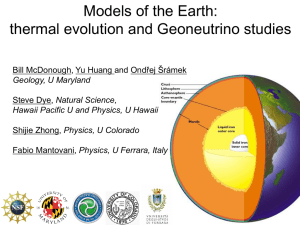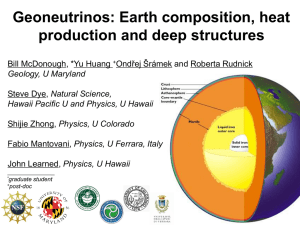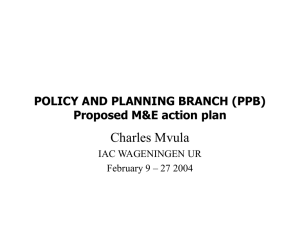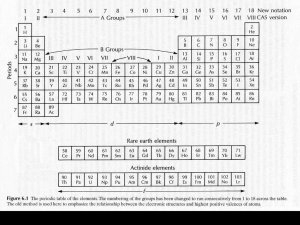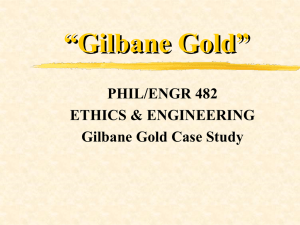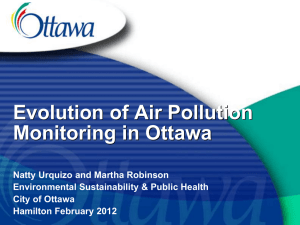pptx
advertisement
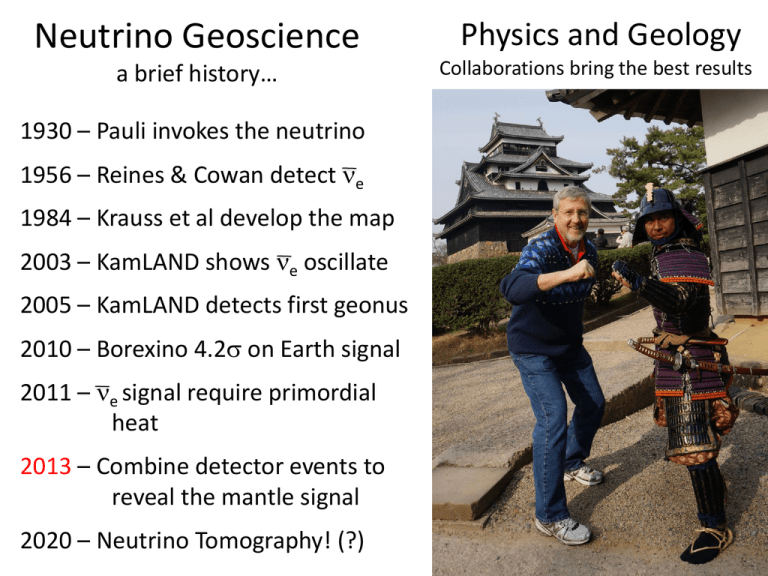
Neutrino Geoscience Physics and Geology a brief history… Collaborations bring the best results 1930 – Pauli invokes the neutrino 1956 – Reines & Cowan detect ne 1984 – Krauss et al develop the map 2003 – KamLAND shows ne oscillate 2005 – KamLAND detects first geonus 2010 – Borexino 4.2s on Earth signal 2011 – ne signal require primordial heat 2013 – Combine detector events to reveal the mantle signal 2020 – Neutrino Tomography! (?) 2011 2005 Detecting Geoneutrinos from the Earth 2010 Nature & amount of Earth’s thermal power radiogenic heating vs secular cooling - abundance of heat producing elements (K, Th, U) in estimates of BSE from 9TW to 36TW the Earth - clues to planet formation processes constrains chondritic Earth models - amount of radiogenic power to drive mantle convection & plate tectonics estimates of mantle 1.3TW to 28TW - is the mantle compositionally layered? or has large layers, LLSVP, superplume piles structures? the future is… Geoneutrino studies U content of BSE models • Nucelosynthesis: U/Si and Th/Si production probability • Solar photosphere: matches C1 carbonaceous chondrites • Estimate from Chondrites: ~11ppb planet (16 ppb in BSE) • Heat flow: secular cooling vs radiogenic contribution… ? • Modeling composition: which chondrite should we use? A brief (albeit biased) history of U estimates in BSE: •Urey (56) 16 ppb Turcotte & Schubert (82; 03) 31 ppb •Wasserburg et al (63) 33 ppb Hart & Zindler (86) 20.8 ppb •Ganapathy & Anders (74) 18 ppb McDonough & Sun (95) 20 ppb ± 20% •Ringwood (75) 20 ppb Allegre et al (95) 21 ppb •Jagoutz et al (79) 26 ppb Palme & O’Neill (03) 22 ppb ± 15% •Schubert et al (80) 31 ppb 17% Lyubetskaya & Korenaga (05) 17 ppb ± •Davies (80) 12-23 ppb O’Neill & Palme (08) 10 ppb •Wanke (81) 21 ppb Javoy et al (10) 12 ppb Earth Models Update: …just the last year! Murakami et al (May - 2012, Nature): “…the lower mantle is enriched in silicon … consistent with the [CI] chondritic Earth model.” Campbell and O’Neill (March - 2012, Nature): “Evidence against a chondritic Earth” Zhang et al (March - 2012, Nature Geoscience): The Ti isotopic composition of the Earth and Moon overlaps that of enstatite chondrites. Fitoussi and Bourdon (March - 2012, Science): “Si isotopes support the conclusion that Earth was not built solely from enstatite chondrites.” Warren (Nov - 2011, EPSL): “Among known chondrite groups, EH yields a relatively close fit to the stable-isotopic composition of Earth.” - Compositional models differ widely, implying a factor of three difference in the U & Th content of the Earth Enstatite chondrite vs Earth Carbonaceous chondrites diagrams from Warren (2011, EPSL) Carbonaceous chondrites Carbonaceous chondrites 142Nd: what does it tell us about the Earth and chondrites? Please stop saying that the e142Nd = 18 ± 5 ppm for chondrites Data from: Gannoun et al (2011, PNAS); Carlson et al (Science, 2007) Andreasen & Sharma (Science, 2006); Boyet and Carlson (2005, Science); Jacobsen & Wasserburg (EPSL, 1984); Qin et al (GCA, 2011) Earth’s surface heat flow 46 ± 3 (47 ± 1) TW Mantle cooling (18 TW) Crust R* (7 ± 1 TW) (Huang et al ‘13) Core (~9 TW) Mantle R* (13 ± 4 TW) - (4-15 TW) total R* 20 ± 4 *R radiogenic heat (after McDonough & Sun ’95) after Jaupart et al 2008 Treatise of Geophysics (0.4 TW) Tidal dissipation Chemical differentiation Summary of geoneutrino results MODELS Cosmochemical: uses meteorites – O’Neill & Palme (’08); Javoy et al (‘10); Warren (‘11) Geochemical: uses terrestrial rocks – McD & Sun ’95; Allegre et al ‘95; Palme O’Neil ‘03 Geodynamical: parameterized convection – Schubert et al; Turcotte et al; Anderson Constructing a 3-D reference model Earth assigning chemical and physical states to Earth voxels 3D imaging of the Earth’s K-Th-U distribution Surface geoneutrino flux Yu Huang et al (2013) arXiv:1301.0365 Early Earth differentiation followed by 4 billion years of plate tectonics Kellog et al (sciences 2000) What’s hidden in the mantle? Seismically slow “red” regions in the deep mantle Can we image it with geonus? No, not that CMB, … Core – Mantle Boundary Retsima et al (Science, 1990) Forming the Moon from terrestrial silicate-rich material (2013) R.J. de Meijer, V.F. Anisichkin, W. van Westrenen (Chemical Geology). Forming the Moon from a geo-reactor at the core-mantle boundary 4.5 Ga The latest form of “fission hypothesis” for the origin of the Moon Mantle geonuetrino flux Mantle = BSE - Crust 14+8 TNU Bellini et al 2013 13 TW 3-8 TW Depleted MORB Mantle 6-10 TW “EL”: hot basal layer Low Q Med. Q High Q (10 ppb U) (20 ppb U) (30 ppb U) Predicted geoneutrino flux Flux at the surface dominated by Continental crust Yu Huang et al (2013) arXiv:1301.0365 Flux at the Moho dominated by deep mantle structures Šrámek et al (2013) 10.1016/j.epsl.2012.11.001; arXiv:1207.0853 Present and future LS-detectors SNO+, Canada (1kt) Borexino, Italy (0.6kt) Europe LENA, EU (50kt) Hanohano, US ocean-based (10kt) KamLAND, Japan (1kt) Future Experiments: world-wide deployable Pauli class research submarine Living and research quarters 10 ktons Hanohano-like n Liquid scintillation Next Gen or WIMP detector Liquid Ar, Xe Segmented research vessel with two detectors “Coincidence counting detectors” International Collaboration Geosciences - Neutrino tomography Physics - Fundamental matter studies Applied - Reactor studies The RV n-Star AN OVERVIEW GOALS LOCATIONS - anywhere in the ocean - depth of 1k - 4k m.w.e. to reduce m-&cosmogenic bkgd - n-beam studies mass hierachy – CP violation reactor neutrinos mantle geoneutrinos artificial neutrino sources supernova neutrinos + geology, biology, monitoring SUMMARY (~before today…) Earth’s radiogenic (Th & U) power 22 ± 12 TW or 11.2 +- 7.9 TW 5.1 Prediction: models range from 8 to 28 TW (for Th & U) On-line and next generation experiments: - SNO+ online 2013/14 - Daya Bay II: good experiment, limited geonu application? - LENA??: will the Europeans push on, put LENA in the ocean! - Hanohano or RV n-Star: this is FUNDAMENTAL for geosciences Geology must participate and it must contribute to the cost -- experiment cost ~$300M; Geology’s contribution $150M; International -- Future: - Neutrino Tomography of the Earth’s deep interior
